The Gift of South Dakota
Subscriptions to South Dakota Magazine make great gifts!
Subscribe today — 1 year (6 issues) is just $29!
Box Elder: Under the Radar
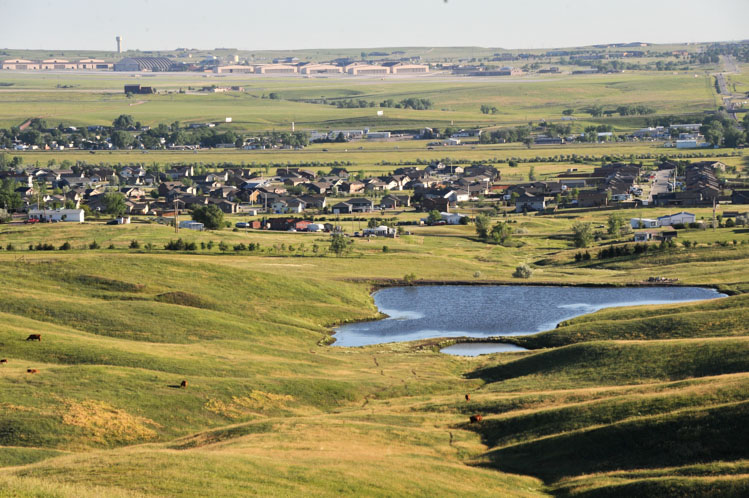 |
| A view from Radar Hill shows Box Elder's expansive landscape. Ellsworth Air Force Base's hangars are visible in the distance. |
Box Elder has been called the South Dakota town that Army and Air Force bombers built. Now, as Ellsworth Air Force Base awaits what will likely be its latest bomber mission — the B-21 — a new breed of builders is also contributing to the city’s rapid growth.
Consider Rob Hrabe, co-founder and CEO of VRC Metals Systems, the high-tech company pioneering cold spray, a process that uses nitrogen or helium to accelerate metal particles in repairing everything from jet components to golf clubs. Box Elder, Hrabe finds, is an ideal setting for building a workforce that mixes retired “crusty master sergeants” and “shiny penny” new engineers from nearby South Dakota School of Mines and Technology in Rapid City.
And there’s Daene Boomsma. He graduated from high school in Box Elder in 2000, served a military stint, then started Boom Construction of Rapid City in 2004. He’s changing Box Elder’s appearance with both housing and commercial developments. “I’m passionate about Box Elder,” he says. “I care about its growth, and how it grows.”
How Box Elder got to this point is a story unlike any other in South Dakota. The railroad first came through in 1907. It was the spot where passengers sometimes stood, stretched their legs, and collected parcels minutes before detraining at Rapid City, just west.
Then in 1937, Rapid City built a modernized airport at Box Elder, and at the same time U.S. Highway 14, though still a dirt road, was moving cars through town toward Mount Rushmore. But Box Elder’s transformation happened in 1942, during World War II. South Dakota’s congressional delegation, and Rapid City’s business and civic leaders, were successful in winning Rapid City Army Air Base where the airport had taken form five years earlier. The base’s first mission proved vital to the United States’ success in the war: training crews for the mighty, four-engine B-17 bomber, a plane deployed aggressively both in Europe and the Pacific.
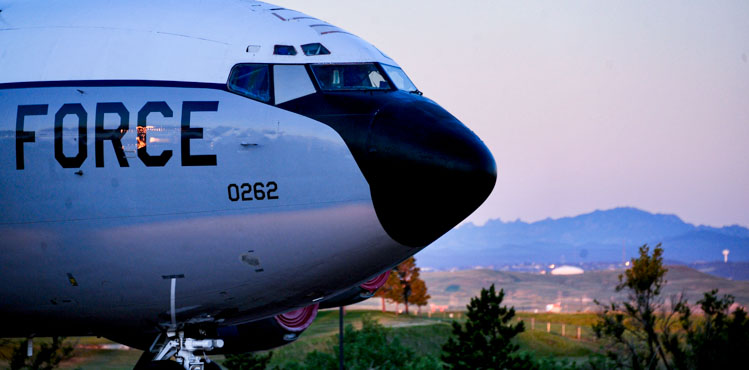 |
| Box Elder's transformation began in 1942, when South Dakota's Congressional delegation secured the Rapid City Army Air Base, today known as Ellsworth Air Force Base. |
For all of Box Elder’s history and easy access — within hours from any point in the world for Ellsworth air crews, and right on Interstate 90 for South Dakota drivers — it’s surprising how many people can’t place the town. In the case of drivers, it’s not like Box Elder passes in the blink of an eye. It stretches from I-90 exits 61 to 67. With a population of about 10,000, the 2020 census will likely reveal it to be the state’s 12th or 13th largest city in population. It’s home to one of the state’s biggest and finest museums, the South Dakota Air and Space Museum.
So why is the town under the radar, so to speak? Many westbound travelers on I-90 think of the community simply as east Rapid City. Locals sometimes refer to the whole area as Ellsworth, or during high school football and basketball seasons as Douglas, the name of Box Elder’s public school district.
The original B-17 veterans are mostly gone now, but for decades they dropped by to recall their World War II training. Other types of Army planes flew in and out of the base then too, and WAC (Women’s Army Corps) units drilled there. But the B-17 dominated, roaring over the Black Hills and across the northern Great Plains.
There was one topic no one wanted to talk about in those years. The rate of training crashes was high everywhere during World War II. Box Elder perpetually braced itself for the worst. When a B-17 went down, usually the entire 10-man crew perished, as was the case close to town over Radar Hill, out in the Badlands, and elsewhere.
The most tragic crash didn’t involve a B-17. It happened eight years after World War II, after establishment of the U.S. Air Force made the Box Elder base part of that military branch. On March 18, 1953, base commander Brigadier General Richard Ellsworth and 22 other airmen died when their B-36 crashed in Newfoundland. Three months later, President Dwight Eisenhower flew to South Dakota to rename the base in Ellsworth’s honor.
The public was invited to honor Ellsworth and to see Eisenhower, and for many Black Hills people the drive was familiar: east of Rapid City on 14 and turn left at Box Elder. The municipal airport had moved a few miles south of Box Elder in 1950, but the Air Force built solid public relations by inviting South Dakotans onto the base regularly. There were flight demonstrations and open houses. The public saw the huge concrete Pride Hangar, the world’s largest monolithic hangar, built to house the B-36. Generally, South Dakotans believed that if the Air Force built something of that magnitude, and with the Cold War looking long-term, their base was a permanent installation.
While the Pride Hangar impressed visitors, many had difficulty thinking of anything that impressed them across the base’s fence in Box Elder. That was often true for newly stationed airmen, too. “I was assigned at Ellsworth from 1964 to ’66, but I lived in Rapid City,” says Leo Coughlin. “What I remember about Box Elder were big service stations on both sides of the road as I drove through, and it seemed like they were always busy.”
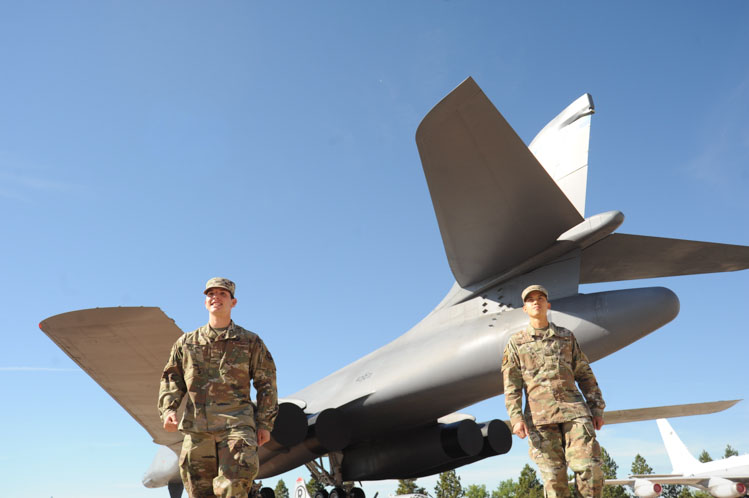 |
| More than 4,000 airmen and civilian workers are based at Ellsworth Air Force Base, including Musta Sonbol (left) and Cheung Lin. |
“In most little South Dakota towns, when you drive into them you find a local cafe and you start to get the feel of the town’s personality,” says Bill Schulz, originally from Kentucky and stationed at Ellsworth a few years after Coughlin. “I think Box Elder was kind of lost that way, sitting between Ellsworth and Rapid City, with no personality of its own.”
As it has grown, Box Elder has seemingly become two cities separated by Interstate 90. North of the highway is the air base, a new city hall building, the high-tech VRC Metals company that stylishly rehabbed an old school building, and many blocks of new homes and apartment buildings. South of the highway, a more eclectic “old town” remains: horses and cattle graze in meadows, and auto repair shops — each with a tiny junkyard of classic cars and jalopies — appear to be the principal economy. Some new residential neighborhoods lie just below Radar Hill, a high spot with satellite antennas operated by the Ellsworth crews. Actually, there’s also a third face to Box Elder. The southwest corner of town is anchored by new hotels and restaurants close to a popular water park called Watiki. Lodgers and diners probably don’t even realize they are in Box Elder, though they contribute significantly to the town’s sales tax revenue and property tax base.
But long ago, the air base became Box Elder’s front porch. It started in the 1960s when Coughlin and Schulz were part of a new Ellsworth mission: Titan and Minuteman nuclear missiles were installed in underground silos across the upper Great Plains, aimed at enemy targets around the globe. Ellsworth personnel were key to the launch process, thankfully never put into action.
“Box Elder then was mostly just trailer houses,” recalls Schulz who, like Coughlin, chose to live in Rapid City. “There was a cop who would pull you over if you drove through too fast. One good thing I remember was a little Asian food market. There were a lot of airmen who had married overseas during the Vietnam years, and their wives got their food there.”
Thirty years after Coughlin and Schulz’s time, Trevor Smith completed an ROTC program at the University of Notre Dame and learned he was to be stationed at Ellsworth. “I remember this panic,” he says. “I didn’t even know where South Dakota was. I drove out there through ranch lands and was thinking, ‘There’s no one living here.’”
Although Smith soon discovered good friends and meaningful volunteer opportunities in the Black Hills, Box Elder didn’t offer any cheer when he first saw it. “Mostly I remember older trailers, and there seemed to be no center to the town,” he recalls. But just as Schulz had noted a specialty business reaching transplanted Asian people, Smith recalled that during the U.S. military’s “don’t ask, don’t tell” period, Box Elder claimed western South Dakota’s only gay bar.
Schulz, who remained in Rapid City after leaving the Air Force and taught for 28 years at Stevens High School, remembers that decades ago he and fellow airmen learned Box Elder was electing a mayor. “And we laughed and asked ourselves, ‘What did the mayor of Box Elder actually do?’”
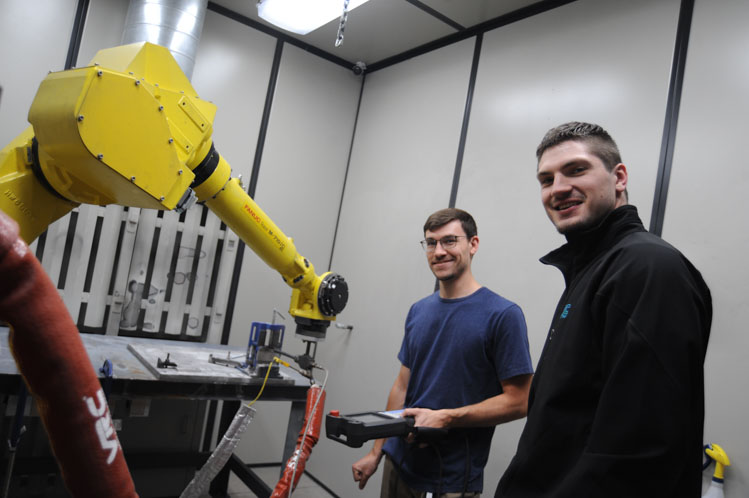 |
| Quentin Goley (left) and Connor Carey are just two of the VRC Metals employees to make the jump from South Dakota Mines in Rapid City. |
Living as a South Dakotan for many years has mellowed Schulz’s attitude, and today he wishes current mayor Larry Larson all the best as Box Elder likely faces population growth related to the B-21’s arrival — perhaps even soaring enrollment in schools already full. It was the Douglas School District that first brought Larson to town in 1972, and his first view was much different than that of Coughlin, Schulz and Smith.
“I had graduated from St. Cloud State in Minnesota and was looking for a teaching job,” Larson says. “There was a list of openings and one was at Ellsworth Air Force Base, South Dakota. A friend suggested if I taught there, I’d probably get Air Force privileges, like being able to hop aboard flights.”
Not true, Larson quickly learned. But what he saw in Box Elder impressed him: a diverse and well-traveled student body, commitment to cutting-edge education, innovative student scheduling and accountability and a carousel school.
“I really wanted to teach in the carousel school,” Larson recalls. He accepted an elementary school grade position, loved it, and within a few years decided he wanted to run for school board — not possible as a school district employee. So he took a teaching job in Rapid City, served on the Douglas board for 36 years, then resigned from that position to run for mayor six years ago.
Topping Larson’s goals has been hiring qualified municipal employees, “people with degrees in their fields,” he says. Also, Box Elder under Larson’s watch is losing those trailer houses that colored Schulz and Smith’s initial impressions. “If you drive by on the interstate, you’ll look off and still see older mobile homes, but that’s changing,” the mayor says. “Nice housing is developing, 100 homes in 2019, plus apartment buildings.”
“It amazes me, the homes that are coming up out there,” confirms Coughlin, the 1960s airman who chiefly remembered busy service stations.
Everyone in the Black Hills, it seems, can list Air Force personnel who decided to remain in the Black Hills after leaving the service, rather than return to their home states (Coughlin is one). Only rarely, though, did they see Box Elder as an option. That’s bound to change as Boomsma and others continue building. Box Elder claims an asset that’s rapidly shrinking in some other Black Hills towns: plenty of acreage left to develop.
It’s not true, Boomsma says, that housing is happening only in anticipation of the B-21. “Our market is good, period,” he notes. “Box Elder is a hot area as a bedroom community. It will be fine even if the B-21 doesn’t come.”
Nor is it true that VRC Metals Systems is in Box Elder only because of the B-21, says company CEO Hrabe, a former B-1B pilot who chose to remain in the Black Hills instead of returning to Kansas. VRC, after all, is a home-grown company, coming out of the School of Mines and Technology business incubator. It demonstrates national and international reach with branch centers across the country, and experiments with products having nothing to do with aviation. For example, in the era of COVID-19, it is winning attention with experiments with metals that could offer self-perpetuating sanitizers.
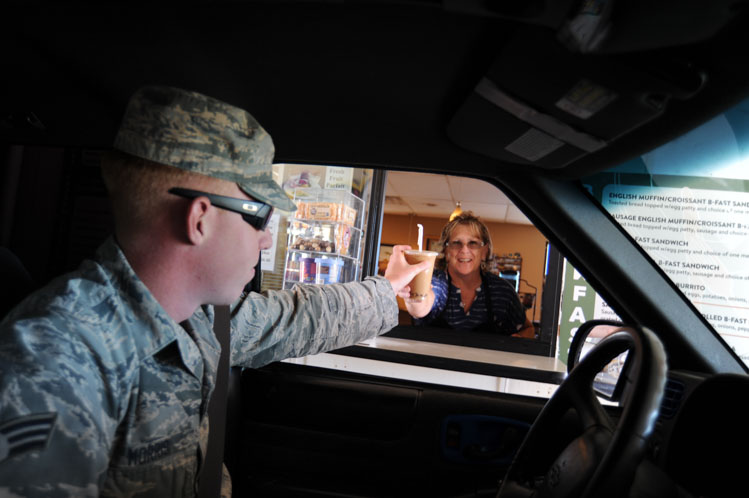 |
| Tracey Scott (pictured) and her husband, Bob, serve many Ellsworth airmen at Gizzi's, their coffee shop. |
What about Trevor Smith’s observation that Box Elder, when he first experienced it in 2004, had no center?
“We hear that a lot,” says Mayor Larson. “We’re working with an urban design architect and calling for community involvement to fix that.”
Plans are in the works for a new commercial district with a road properly named Main Street. South Dakota main streets typically become gathering places for festivals, music and even outdoor movie screenings. Box Elder started the tradition this summer, with food trucks and live music on Tuesday nights and movies on Fridays thanks to a big screen that the Elks Theater of Rapid City brought to town.
Though Box Elder has never promoted itself as a tourist town, the remarkable South Dakota Air and Space Museum claims a loyal following that extends far beyond the state. The museum interprets the full story of the Air Force, and stories of South Dakotans — military or civilian — who contributed to aviation. Museum galleries were closed due to the pandemic early this summer, but nonetheless cars from Alabama, Arizona, Illinois, Nevada and Minnesota were parked at the big museum, which looks like an airfield of vintage planes that tell the stories of World War II, the Berlin Airlift, Korea, Vietnam and the Middle East wars. Some are actual planes connected to major historical figures, including the B-25 that Eisenhower converted for his personal transport in 1944 and 1945 and the F-102 that early astronaut Gus Grissom used to keep his piloting skills sharp.
Not much is missing, although there’s no example of the B-17 — the plane that started everything at Ellsworth. Anyone who has a B-17 they’d be willing to part with will receive a warm welcome in Box Elder. Don’t worry about a few dings on the old plane. Those can be cold-sprayed away just up the street.
Editor’s Note: This story is revised from the September/October 2020 issue of South Dakota Magazine. To order a copy or to subscribe, call (800) 456-5117.







Comments